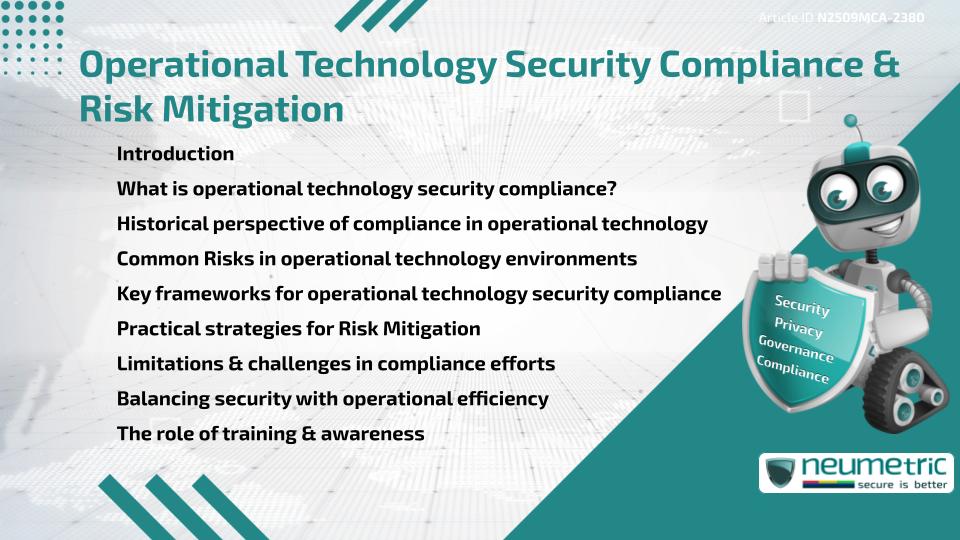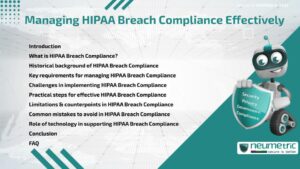Table of Contents
ToggleIntroduction
Operational technology security compliance ensures that industrial systems like energy grids, transportation networks & Manufacturing plants remain protected from both cyber & physical Risks. This process involves applying frameworks, Policies, Technologies & Processes to safeguard essential assets & reduce Risks that may disrupt operations. Without strong compliance measures, organisations face Safety issues, downtime, Regulatory Standards violations & Financial losses. Operational technology security compliance not only reduces Vulnerabilities but also strengthens trust between companies, regulators & the public.
What is operational technology security compliance?
Operational technology refers to hardware & software systems that monitor or control physical devices, processes & infrastructure. Security compliance in this context means adhering to Regulatory Compliance Requirements & Security Controls that ensure these systems are protected against unauthorised access, manipulation or failure. Unlike Information Technology, operational technology operates in real-time & interacts directly with the physical environment, making its compliance needs more stringent.
Read more about operational technology systems
Historical perspective of compliance in operational technology
Initially, operational technology systems were isolated & considered safe from external attacks. However, with the integration of digital technologies, the lines between Information Technology & operational technology have blurred. This connectivity has opened doors to Cybersecurity Threats. Over time, Industry Regulations such as NERC CIP for energy & IEC 62443 for industrial control systems emerged to enforce operational technology security compliance & protect critical infrastructure.
Common Risks in operational technology environments
Operational technology systems face several Risks, including:
- Physical disruption from malfunctioning equipment or intentional sabotage
- Cyber Threats such as ransomware, malware & remote access attacks
- Human errors resulting from lack of training or weak Security Policies
- Supply chain issues that compromise trust in Third Party vendors
These Risks can have direct consequences such as production stoppages or Safety hazards, making operational technology security compliance a priority.
Cybersecurity Risks in industrial control systems
Key frameworks for operational technology security compliance
Several frameworks guide organisations in achieving effective operational technology security compliance:
- NIST Cybersecurity Framework: Helps assess & manage Risks in industrial environments
- IEC 62443: Provides globally accepted guidelines for industrial automation security
- NERC CIP: Focused on the energy sector’s critical systems
- ISO 27001 Certification: Supports organisations in managing Security, Availability, Processing Integrity, Confidentiality & Privacy
These frameworks act as roadmaps for implementing Security Measures & Risk Mitigation Efforts in critical infrastructure.
Practical strategies for Risk Mitigation
Risk Mitigation in operational technology requires a combination of technical & organisational strategies:
- Implementing strong Access Controls & Monitoring Tools
- Conducting regular Risk Assessments & Penetration Testing
- Applying Patch Management & Security Monitoring
- Ensuring a strong Incident Response Plan is in place
- Conducting Continuous Training for Employees
By combining these strategies, organisations can address both known & emerging Risks effectively.
Detailed NIST Cybersecurity Framework
Limitations & challenges in compliance efforts
While compliance frameworks provide strong guidance, there are challenges:
- High costs of implementation
- Difficulty in aligning Security Controls with real-time operations
- Resource Constraints in Small Businesses
- Evolving Cyber Threats that outpace existing frameworks
Compliance is necessary, but it is not a guarantee of complete security.
Balancing security with operational efficiency
Too much emphasis on strict compliance may slow down industrial processes. For example, excessive authentication steps can delay urgent actions in critical systems. The goal should be to maintain operational technology security compliance without disrupting Business Operations. This balance requires careful Risk Management & expert decision-making.
The role of training & awareness
Technology alone cannot secure operational technology environments. Employees need proper Training Programs that highlight Security Policies, Incident Response procedures & the importance of reporting anomalies. When Employees understand the stakes, compliance becomes part of the organisational culture.
Conclusion
Operational technology security compliance protects critical infrastructure from Risks that could disrupt industries & harm the public. By following established frameworks & applying practical Risk Mitigation Efforts, organisations can strengthen resilience & maintain trust.
Takeaways
- Operational technology security compliance is essential for protecting industrial systems.
- Frameworks like IEC 62443, NERC CIP & ISO 27001 Certification guide compliance efforts.
- Risks include cyberattacks, human error & supply chain Vulnerabilities.
- Risk Mitigation requires technical controls, training & Incident Response planning.
- A balance between compliance & operational efficiency is necessary.
FAQ
What is operational technology security compliance?
It refers to the application of Policies & frameworks to protect industrial systems from Cyber Threats, disruptions & Safety hazards.
Why is compliance important in operational technology?
It helps prevent disruptions, regulatory penalties & security breaches that could endanger public safety.
What frameworks guide operational technology security compliance?
Key frameworks include NIST, IEC 62443, NERC CIP & ISO 27001 Certification.
What are the main Risks in operational technology environments?
Risks include Cybersecurity Threats, equipment failure, human error & supply chain compromises.
How does Risk Mitigation support compliance?
Risk Mitigation Efforts like Access Controls, Incident Response planning & training ensure compliance & resilience.
What challenges do organisations face in compliance?
Challenges include cost, resource limitations & rapidly evolving Threats.
How does Employee Training support compliance?
Training ensures Employees understand Security Policies, reducing the Likelihood of errors & strengthening compliance culture.
Need help for Security, Privacy, Governance & VAPT?
Neumetric provides organisations the necessary help to achieve their Cybersecurity, Compliance, Governance, Privacy, Certifications & Pentesting needs.
Organisations & Businesses, specifically those which provide SaaS & AI Solutions in the Fintech, BFSI & other regulated sectors, usually need a Cybersecurity Partner for meeting & maintaining the ongoing Security & Privacy needs & requirements of their Enterprise Clients & Privacy conscious Customers.
SOC 2, ISO 27001, ISO 42001, NIST, HIPAA, HECVAT, EU GDPR are some of the Frameworks that are served by Fusion – a SaaS, multimodular, multitenant, centralised, automated, Cybersecurity & Compliance Management system.
Neumetric also provides Expert Services for technical security which covers VAPT for Web Applications, APIs, iOS & Android Mobile Apps, Security Testing for AWS & other Cloud Environments & Cloud Infrastructure & other similar scopes.
Reach out to us by Email or filling out the Contact Form…





